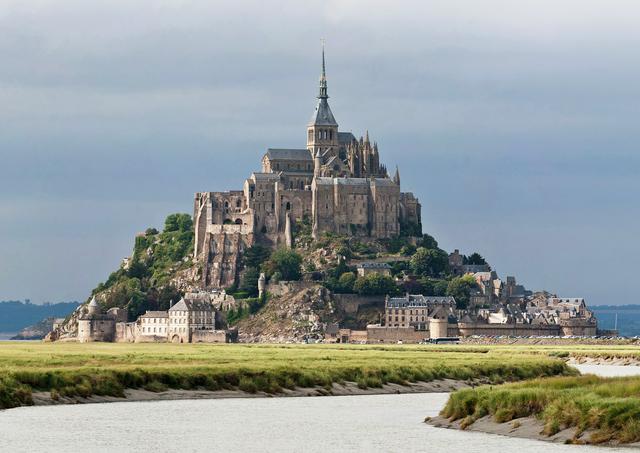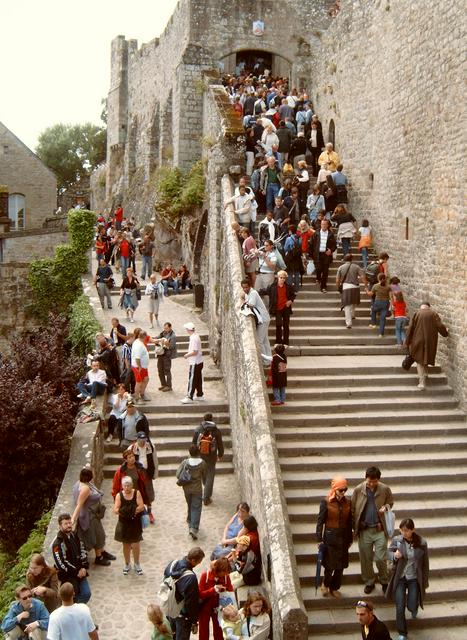
Mont Saint-Michel (often written Mont St Michel, with other variations) is a small UNESCO World Heritage site located on an island just off the coast near Avranches in the region of Lower Normandy in northern France. The island is best known as the site of the spectacular and well-preserved Norman Benedictine Abbey of St Michel at the peak of the rocky island, surrounded by the winding streets and convoluted architecture of the medieval town.
Mont Saint-Michel was officially inscribed as a World Heritage Site in 1979.
Mont-Saint-Michel was used in the 6th and 7th centuries as an Armorican stronghold of Romano-Breton culture and power, until it was ransacked by the Franks, thus ending the trans-channel culture that had stood since the departure of the Romans in AD 460.
Before the construction of the first monastic establishment in the 8th century, the island was called "monte tombe". According to legend, the Archangel Michael appeared to St. Aubert, bishop of Avranches, in 708 and instructed him to build a church on the rocky islet. Aubert repeatedly ignored the angel's instruction, until Michael burned a hole in the bishop's skull with his finger.
The mount gained strategic significance in 933 when William "Long Sword", William I, Duke of Normandy, annexed the Cotentin Peninsula, definitively placing the mount in Normandy. It is depicted in the Bayeux Tapestry which commemorates the 1066 Norman conquest of England. Harold, Earl of Wessex is pictured on the tapestry rescuing two Norman knights from the quicksand in the tidal flats during a battle with Conan II, Duke of Brittany. Norman Ducal patronage financed the spectacular Norman architecture of the abbey in subsequent centuries.
In 1067, the monastery of Mont-Saint-Michel gave its support to duke William of Normandy in his claim to the throne of England. It was rewarded with properties and grounds on the English side of the Channel, including a small island located to the west of Cornwall, which was modeled after the Mount, and became a Norman priory named St Michael's Mount of Penzance.
During the Hundred Years' War, the English made repeated assaults on the island, but were unable to seize it due to the abbey's improved fortifications. Les Michelettes – two wrought-iron bombards left by the English in their failed 1423–24 siege of Mont-Saint-Michel – are still displayed near the outer defense wall.
When Louis XI of France founded the Order of Saint Michael in 1469, he intended that the abbey church of Mont Saint-Michel be the chapel for the Order, but because of its great distance from Paris, his intention could never be realized.
The wealth and influence of the abbey extended to many daughter foundations, including St Michael's Mount in Cornwall. However, its popularity and prestige as a centre of pilgrimage waned with the Reformation, and by the time of the French Revolution there were scarcely any monks in residence. The abbey was closed and converted into a prison, initially to hold clerical opponents of the republican régime. High-profile political prisoners followed, but by 1836, influential figures – including Victor Hugo – had launched a campaign to restore what was seen as a national architectural treasure. The prison was finally closed in 1863, and the mount was declared a historic monument in 1874. The Mont-Saint-Michel and its bay were added to the UNESCO list of World Heritage Sites in 1979, and it was listed with criteria such as cultural, historical, and architectural significance, as well as human-created and natural beauty.
- Abbey of Mont Saint Michel. 2 May - 30 August 9am-7pm (last admission 6pm), 1 September - 30 April 9:30am-6pm (last admission 5pm). Closed 1 January, 1 May and 25 December. Once a humble little monastery, the island and its fortifications have effectively grown up around this. During the French Revolution, the abbey was used a prison, and an extensive restoration was required to restore it. A few prison-era showpieces, like the human hamster wheel used to lift supplies in and out of the complex, have been kept. Mass is celebrated daily except Monday at 12.15PM. Unguided visits: €9 adult, €5 18-25 yrs (free for citizens of the EU), and free for under 18s. €4 audio guide (French, English, German, Spanish, Italian).
- Chapelle Notre-Dame Sous Terre. The Carolingian church was built around 966 by the first Benedictine monks at the very place of the oratory erected by Saint-Aubert in the early VIIIth century.
Abbey of Mont Saint Michel. 2 May - 30 August 9am-7pm (last admission 6pm), 1 September - 30 April 9:30am-6pm (last admission 5pm). Closed 1 January, 1 May and 25 December. Once a humble little monastery, the island and its fortifications have effectively grown up around this. During the French Revolution, the abbey was used a prison, and an extensive restoration was required to restore it. A few prison-era showpieces, like the human hamster wheel used to lift supplies in and out of the complex, have been kept. Mass is celebrated daily except Monday at 12.15PM. Unguided visits: €9 adult, €5 18-25 yrs (free for citizens of the EU), and free for under 18s. €4 audio guide (French, English, German, Spanish, Italian).
Chapelle Notre-Dame Sous Terre. The Carolingian church was built around 966 by the first Benedictine monks at the very place of the oratory erected by Saint-Aubert in the early VIIIth century.
Many companies provide guided walks across the bay of Mont St Michel during low tide. Walks are done barefoot, and in shorts due to the muddy ground and potentially knee-high water. Walks are typically one-way, start at a beach such as Genets, and end after reaching the Mont . Foot-washing stations are provided at the Mont to clean muddy feet. Guided roundtrip walks starting from the Mont are also available and typically last 3-4 hours. Most walks are conducted in French, so check carefully before booking. A list of guides is provided here:
The culinary specialities of Mont Saint Michel are Omelettes, whipped until frothy and light, and saltmarsh lamb (agneau de Pré Salé) dishes from the sheep that wander around the coast. None of the eateries on the island are particularly good (and they are all vastly overpriced) so if you are planning on staying on the Mont itself be aware that you might prefer eating in a town in the surrounding countryside.
The old town at the base of the abbey hosts a wide selection of restaurants, cafés, fast food outlets and other food venues. Note that Mont Saint Michel is more than slightly a tourist trap with regard to refreshments and travellers' needs - check a number of places for the best deal before ordering. Even then, do not rely on good service.
- Du Guesclin. On the ramparts with good views out to the sea. The menu touristique, including oysters, omelets and lamb, starts from €17, which is positively cheap by Mont St Michel standards.
- La Mère Poulard. World famous for their omelette. They put non-traditional ingredients into it and cook it right in front of the window of the restaurant. Be careful to make reservations ahead of time because it is usually crowded. Also they only sell their world famous omelette at certain times of the day, so when you make reservations, be sure to make them for the right time if you're intending to get an omelette. €30 or more.
Du Guesclin. On the ramparts with good views out to the sea. The menu touristique, including oysters, omelets and lamb, starts from €17, which is positively cheap by Mont St Michel standards.
La Mère Poulard. World famous for their omelette. They put non-traditional ingredients into it and cook it right in front of the window of the restaurant. Be careful to make reservations ahead of time because it is usually crowded. Also they only sell their world famous omelette at certain times of the day, so when you make reservations, be sure to make them for the right time if you're intending to get an omelette. €30 or more.
On the approach road to the mont is a small area of shops, restaurants and supermarkets, although not cheap, they are less un-reasonably priced than getting food on the island. There is also (limited) car parking there.

Due to the tourist nature of the Mont it can get very busy, especially in high summer. Because of the steep steps up to the abbey, people can sometimes feel unwell, and may want to rest in the numerous gardens throughout the Mont with plenty of seats. Keep walking when others are behind you as causing a blockage is likely to annoy them.
Sunday is a good day to avoid visiting the Mont as it tends to be the most popular day of the week. It is also best to avoid the middle of the day as coach tours arrive around 10.30am and leave around 4pm, so visiting outside of these hours is advisable to miss the largest crowds.
The local Office de Tourisme is located in the Corps de Garde des Bourgeois (the Old Guard Room of the Bourgeois), at the left of the town gates (tel 02-33-60-14-30). Open daily all year except for Christmas Day and New Years Day.
Another helpful tourist office is open during the daytime next to the car park where the free Passeur shuttle buses pick you up. Left luggage lockers are accessible 24-hours, cost 1 euro, and the coin is returned upon retrieving your luggage.
The tidal mudflats surrounding the island contain areas of deep mud and quicksand. Visitors to the island are advised not to attempt crossing the flats by foot. However, if you decide to attempt the crossing, be prepared to take off your shoes and clean up your feet afterwards, as the flats are extremely muddy. The tide here is one of the fastest-rising in Europe, and as such you should never attempt any walks on the sands without checking the tide tables. It is also advisable to only attempt the crossing with a qualified guide.
The Mount has several steep staircases, sheer drops, and uneven ground. Keep your children under close watch and ensure that you pay due attention at all times.
